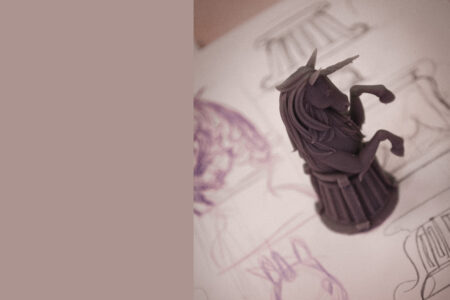February 14, 2017
Once NBCCD Textile Design alumna WhiteFeather Hunter receives her PhD in BioArt, she jokes she will be able to refer to herself as a true “witch doctor.”
When you read the list of projects she’s been involved in, it might make sense; it includes growing mouse matter on her own hair as looms, knitting bones, and researching the process of fermenting lichen with her own urine.
According to Wikipedia, BioArt is “an art practice where humans work with live tissues, bacteria, living organisms and life processes. Using scientific processes such as biotechnology (including technologies such as genetic engineering, tissue culture, and cloning), the artworks are produced in laboratories, galleries, and artists’ studios.”
After receiving a diploma in textile design at NBCCD and a Masters Degree in fibre arts, Hunter is now working as principal investigator at The Speculative Life Lab and coordinator at the Textiles and Materiality Research Cluster. Both are part of the Milieux Institute for Arts, Culture, and Techology at Concordia University in Montréal.
Hunter said she has always loved textiles, mythology, and historical textile techniques as well as the intersection of BioArt.
She completed her first year at NBCCD and following that took some time off to travel. It wasn’t until 3 years later, when a Textiles student snuck her into the studio at night and sat her down to show her how to put her first warp on a loom, that Hunter became hooked.
The schedule at NBCCD was very flexible to her life at a single mom, and WhiteFeather thrived. She was able to care for her son, graduate from NBCCD, and get hired as an instructor. During this time, she pursued her Bachelor of Applied Arts, a degree pathway partnership between the University of New Brunswick and the New Brunswick College of Craft and Design.
WhiteFeather’s textile work has always involved organic materials and a keen interest in historical techniques and traditions, which she is now combining with bioscience.
WhiteFeather’s poppets, created for the very first exhibition at NBCCD’s George Fry Gallery, were handmade dolls incorporating textiles, bones, feathers, and other organic matter. They were themselves referencing voodoo, mythology, and sometimes witchcraft or shamanic practices.
In Ottawa, she studied under Andrew Pelling at Pelling Lab in Ottawa, who deeply and profoundly influenced her pursuit of technological training in the lab. This workshop training began an interest in growing mammalian tissue on textiles and a keen interest in crafting tissue engineering, with an emphasis on textiles and bio systems working together. In a residency in Australia, WhiteFeather worked on knitting bones in the laboratory. She has also used her own hair as a traditional loom and grew mouse tissue on it.
She says this raises the question of “what is it now?”…it’s not human, and not mouse, and what can it become?
A recent trip to Iceland saw Hunter using landscape as laboratory, and engage in scraping lichen. She is currently researching the use of her own bodily fluids (specifically urine) on lichen to obtain traditional textile dyes. In Finland, she will continue related work at a residency there, where fermented urine is used to dye lichen in a traditional indigenous natural dye technique. Hunter is hoping to merge new technologies into this ancient process. She will also have yarns dyed through these processes and plans to incorporate those materials into a woven piece.
Recently Hunter has learned she is directly related to Icelandic people through genome mapping which has fueled an interest in genomic data – specifically using chromosomes from her own DNA. She said she plans to weave her DNA’s own pattern into a woven textile that will incorporate dried organic materials she collected in Iceland.
Hunter will soon work with a group in Montreal that will be growing and tanning Kombucha scoby, a culture of bacteria and yeast, into leather. In early February, she was invited to go to the Transmediale Festival in Berlin. She will be part of a research group visiting the Natural History Museum, to film, document, and problem solve what to do with their incredible collection from around the world.
Hunter is deeply interested in this new area of artists and scientists collaborating on innovative ways to approach biotechnologies, and to use biological transformation processes.
Hunter is planning on completing a PhD in BioArt someday. She said Europe has been on the cutting edge of this new area for 10 years and the Netherlands, Australia, and the United Kingdom have well accepted and established bio art cultures.
Hunter said her time at NBCCD was extremely valuable and provided a solid basis for all her current endeavours She says the foundation in technical skills at NBCCD was invaluable and of the highest calibre. It’s great to desire and strive to be conceptual, she said, but it’s not as possible to attain without an extremely technical skills foundation. She says she will always cherish the time spent at NBCCD.





